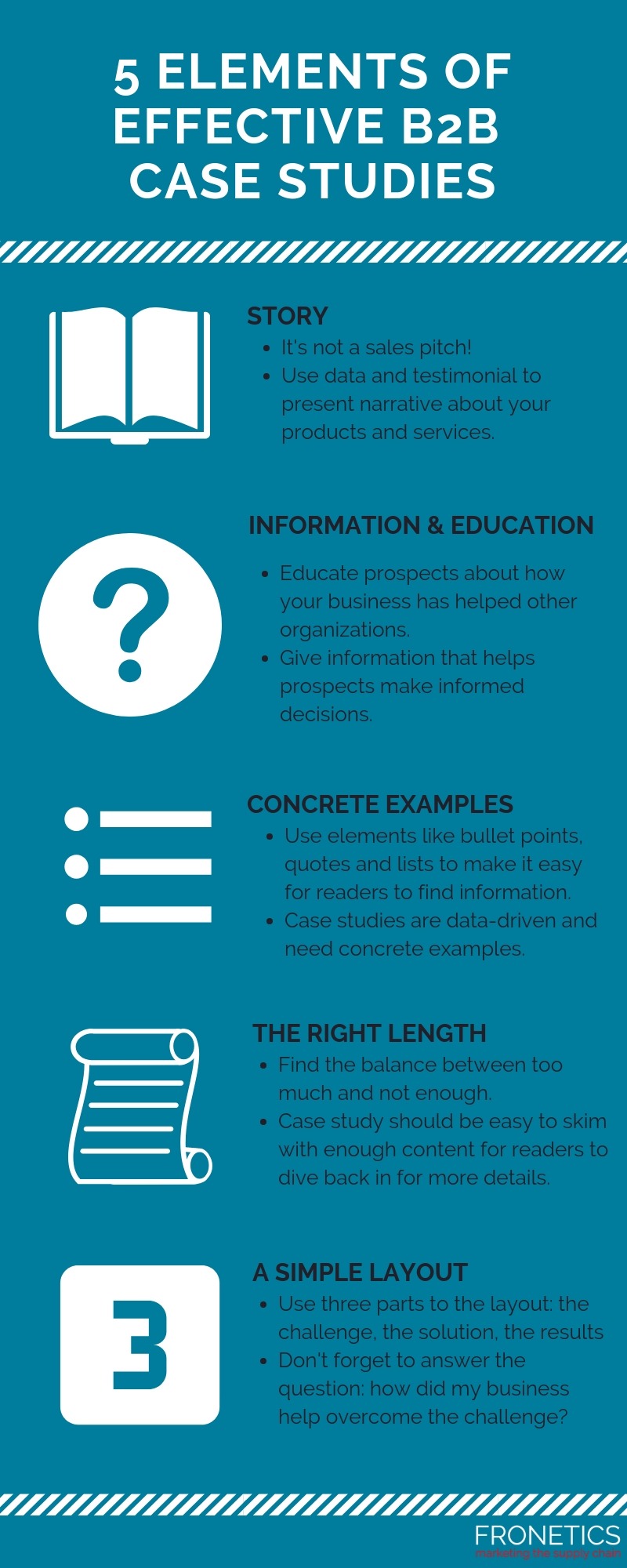
by Fronetics | Nov 19, 2018 | Blog, Content Marketing, Logistics, Marketing, Supply Chain
For B2B buyers, case studies are still the most popular type of content. Check out our infographic below to discover the five elements of an effective B2B case study.
Did you know that 89% of B2B marketers consider customer testimonials and case studies to be the most effective kinds of content in converting buyers? A well-written case study engages prospects and generates leads. But what is an effective case study? And how do you create one?
[bctt tweet=”Did you know that 89% of B2B marketers consider customer testimonials and case studies to be the most effective kinds of content in converting buyers?” username=”Fronetics”]
These five elements are the key to maximizing the effectiveness of your case study:
1. Story
While it’s true that case studies are about the data, what makes them attractive to buyers is the story. This isn’t a sales pitch — it’s an opportunity to use data and testimonials to present a narrative to prospects about how your products and services helped another business.
2. Information and education
Think of your case study as an opportunity to educate your prospects about how your business has helped organizations similar to their own. Again, this is not a sales pitch. In fact, case studies that are written as sales pitches tend to be ineffective. A case study gives your prospects information and educates them so they can make an informed decision about what’s best for their business.
3. Concrete examples
Case studies are data-driven and offer concrete examples. This is one of the primary reasons they are a high-performing content type. An effective case study makes it easy for readers to find the information they’re looking for, using elements like bullet points, quotes, and lists to clearly and concisely convey key data.
4. The right length
There’s a delicate balance between presenting complete information, telling a story, and avoiding minutia that’s too specific to matter to your prospects. Ideally, you want your reader to be able to skim quickly and get an overall view, and then dive back in for more details. If your case study leaves your prospect with questions about how your products and services helped another business, chances are it doesn’t include enough information.
5. A simple outline
- The Challenge: What challenge or challenges was your customer facing before working with you?
- The Solution: How did your business address the challenges your customer was facing?
- The Results: How do your metrics demonstrate the immediate and ongoing results of your solution?

(Made with Canva)
The takeaway
Case studies are your opportunity to use your successes to create a narrative, supported by key metrics, that demonstrates how your business successfully addressed the challenges faced by your customers. Telling a compelling story is one of the best ways to engage your prospects and convert leads.
Related posts:


by Fronetics | Nov 9, 2017 | Blog, Content Marketing, Customer Service, Marketing
Case studies have proven to be one of the most effective kinds of content in converting leads to buyers. Here are 4 strategies to getting customers to participate.
The 2017 Content Preferences Survey Report found that 78% of B2B buyers used vendor case studies as part of their purchasing decisions in the past 12 months. So why are customer testimonials and case studies so effective? Because buyers value the opinions of their peers and colleagues.
In fact, 89% of B2B marketers consider customer testimonials and case studies as the most effective kinds of content in converting buyers. It makes sense: User reviews offer an unbiased, credible experience regarding a company’s products or services. So potential customers do not have to rely exclusively on information the organization provides.
With stats like that, it is easy to see that case studies are compelling, but getting customers to participate in case studies can be very challenging. Here are 4 tips to help increase case study participation.
4 strategies to get customers involved in your case study
Create a formal process.
Start by getting support from your sales and marketing teams. With compelling stats about the success of case studies and customer testimonials, your internal teams will be jumping at the chance to help find participants. After all, these customers will help drive new sales.
Next you will need a formal submission process for sales and marketing team members to complete when they want to submit a customer’s name and information. You will also need a detailed document that explains to participants their level of involvement. People are busy! Keep case studies short and sweet so nominees are more likely to participate.
Be smart with your timing.
Case studies are most effective when you have happy, satisfied customers beaming about your products. Be smart with your timing and ask customers who just recently purchased your products or services. These customers are most likely excited about their recent purchase and may even go one step further in their reviews, offering tips and how-tos that will only add to the success of your case study.
Not sure if customers are happy with their recent purchase? Ask them! Send an email that asks if they’re satisfied. If their response shows excitement, ask if they’d be willing to participate.
Treat the case study as a mutual opportunity
Case studies can be beneficial to you and your participants, and should be treated as such. “Many customers already think doing business with you is a favor they did. You should not make them feel like they’re going to be doing you another favor by doing a case study,” writes Ayodeji Onibalusi for Effective Inbound Marketing.
Let customers see your case study as an opportunity for them. Explain the benefits, including publicity, they will achieve from participating. Post your case study to social media, link to your website, and send to existing and potential customers. A case study is something your participants can enjoy and won’t want to miss out on.
Find alternatives if customer polices prohibit case studies
Company policies that restrict or forbid some customers from participating in case studies are a big roadblock. Your company could have strict polices about customer testimonials, or customers might have restrictive company policies that limit their participation. These can be a challenge but don’t have to quash your opportunity to conduct successful case studies.
Get creative if you must! Conduct large group interviews and take samples of customer testimonials. Or use the average results from the interview to create an anonymous case study. If you’re still running into issues, simply ask customers for a one-sentence review that you can post without their information. These short reviews can still have a big impact on potential customers.
Case studies have proven they are worth their time and energy. Recommendations from actual customers are a powerful tool. Use these four strategies to conduct case studies that will help attract new customers and drive sales.
Related posts:






